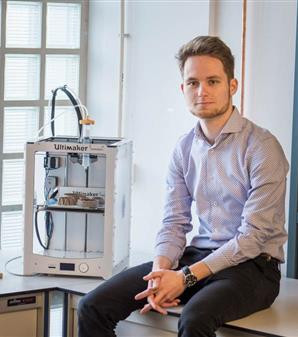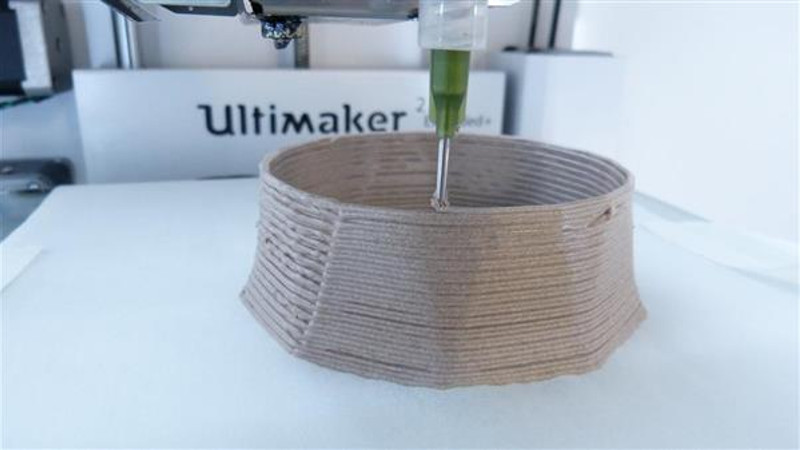What do you get when you combine oven-baked mussels and sugar beets in a kitchen blender? No, it isn’t some new smoothie cleanse or fad diet. It’s an experimental new recyclable 3D printing material developed by [Joost Vette], an Industrial Design Engineering student at Delft University of Technology in the Netherlands. While some of the limitations of the material mean it’s fairly unlikely you’ll be passing over PLA for ground-up shellfish anytime soon, it does have a few compelling features worth looking into.

For one thing, it’s completely biodegradable. PLA is technically biodegradable as it’s usually made primarily of cornstarch, but in reality, it can be rather difficult to break down. Depending on the conditions, PLA could last years exposed to the elements and not degrade to any significant degree. But [Joost] says his creation degrades readily when exposed to moisture; so much so that he theorizes it could have applications as a water-soluble support material when printing with a multiple extruder machine.
What’s more, after the material has been dissolved into the water, it can be reconstituted and put back into the printer. Failed prints could be recycled directly back into fresh printing material without any special hardware. According to [Joost], this process can be repeated indefinitely with no degradation to the material itself, “A lot of materials become weaker when recycled, this one does not.”
So how can you play along at home? The first challenge is finding the proper ratio between water, sugar, and the powder created by grinding up mussel shells necessary to create a smooth paste. It needs to be liquid enough to be extruded by the printer, but firm enough to remain structurally sound until it dries out and takes its final ceramic-like form. As for the 3D printer, it looks like [Joost] is using a paste extruder add-on for the Ultimaker 2, though the printer and extruder combo itself isn’t going to be critical as long as it can push out a material of the same viscosity.
We’ve seen a number of DIY paste extruder mods for 3D printers, which is a good starting point if you’re getting sick of boring old plastic. Before long you might find yourself printing with living tissue.
[Thanks to Mynasru for the tip]
















I imagine it must be difficult to keep the viscosity constant during a longer print. It would seem to me the paste might be drying out as times goes on unless there is something that stirs the slurry and moisture can be added as required.
It’s inside a sealed syringe.
Enough material for the entire print, even if it takes 10 hours is in a sealed syringe? I did not read that anywhere and it does not seem possible. I thought it was being from a hopper.
Opps…that was supposed to be…I thought it was being fed from a hopper of some kind. Maybe I missed the sealed syringe part but it does not seem practical if that’s all the material it can hold for a print.
Also, I wonder if he has even tried firing these parts in a kiln to see if that fuses it together like a ceramic?
Sounds like Diatomaceous earth and sugar and water makes this stuff up.
This new idea sounds cool. And if I had a 3D printer or something with a simular axes control. (CNC) Iwould totally attempt it.
“I met a man in Brussels, he 3D printed using Mussels.”
And the winner of today’s internet is… ;)
‘I said do you speak-a my language, he just smiled and gave me a sugar beet sandwich.’
You still must have close ties to the land of injustice to forgo the Vegemite and rub the bread thing in our faces…
Our local lakes are having trouble with invasive zebra mussels. This might be a way to turn a pest into a resource…
6 microns tall and bio polymer unstable.. I got nothing. Can’t sing either. Not giving out recipe? Awww.
…So how does it smell?
>PLA is technically biodegradable as it’s usually made primarily of cornstarch
ABS is made from dinosaurs, so it’s also biodegradable? Bad HaD! Bad science.
While PLA has some compostable properties as comments on the previous article point out. It has little to do with being made from biological products.
theres a relevant xkcd but i cant find it
will for you with me all go
“Smoothie diet” ! I approve !
Dammit… I’ll go ahead and be the one to chunder on this parade… the energy you put into the mussel shells is absolutely wasted. The shells themselves can be discarded as per the usual processes without wasting considerable resources to make stinky lampshades that nobody wants.
I’ll second your chunder.
This smells a bit like gimmicky hype. Whilst I obviously applaud Mr Vette for getting stuck in and experimenting, in the end its basically a fish paste extruder. How hard is the ‘ceramic-like’ material that is produced?
” ….the material can be recycled simply by dissolving it in water…” So not very ‘ceramic-like’ after all?